skip to main |
skip to sidebar
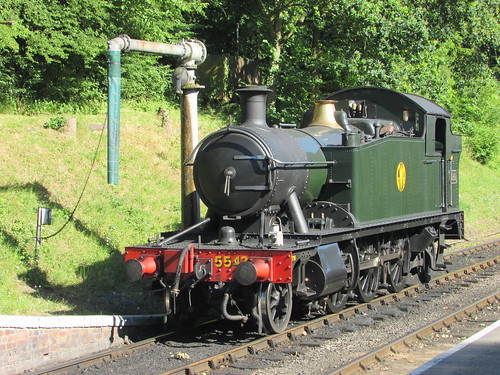
Shackerstone Station: Saturday, 30th June 2018
In 2018, 5542 returned to Shackerstone just after Easter following scheduled repairs at the South Devon Railway. My first driving 'turn' after the locomotive's return was a 'Fish and Chip Evening Special on Saturday, 9th June 2018 (described here) then I did a full day on Saturday, 23rd June 2018 when we had a 'Silver' Footplate Experience course prior to the service trains. A week later I was back again. You might imagine that driving the same locomotive on the same stretch of line a number of times would become boring. It never seems so to me - every trip is a little different.
Events of Saturday, 30th June 2018
In what struck me as a neat inversion of what had happened on the 9th June (when Carl was driver during the day and I took over for the evening service), this time I was driver for the five service trains during the day then, after watering the locomotive, I handed it over to Carl who was taking the evening round trip which, this time, was a Murder Mystery Dining train.
There was no Driving Experience Course prior to the first service at 11.00 a.m. so signing-on for Preparation duties did not have to be too early. But it's always helpful to have time on your side during preparation as the crew never know what may happen. Unusually, the married couple of Rod and Tracy Tye (both experienced footplate crew) were rostered as fireman on a 'buy one, get one free' basis so we were not under undue pressure.
On preserved lines, the driver and fireman sometimes have a safety-qualified trainee rostered as a 'Cleaner', both to learn about firing and boiler management and also assist in other tasks although this was not the case on the 30th. This practice is an echo of the old days when cleaners were given occasional trips on the footplate to learn the essential practical skills. Throughout their careers, footplatemen were helped to make progress in acquiring the necessary technical knowledge and familiarity with the Rule Book by attending Mutual Improvement Classes, briefly described here. A section of this blog (labelled 'MIC') has technical information of the sort which was formerly imparted in Mutual Improvement Classes. You can find all the posts labelled 'MIC' here or find a list of these posts (not always up-to-date) here.
Preparation
The term 'Preparation' covers both Driver's and Fireman's duties in getting a locomotive ready for traffic. In general, the Driver is responsible for the daily examination of the locomotive and 'oiling round' whilst the Fireman concentrates on raising steam but ideally the crew work together as a team to ensure that all the tasks are carried out efficiently. Proper attention to raising steam, oiling and the 'daily exam' helps to prevent failures 'on the road' later. There are a couple of posts in this blog dedicated to 'Preparation' activities on 'Austerity' tank engines:-
Driving Turn at Peak Rail - Part One: Preparation
Preparation of Locomotive 'Sapper'
However, because of its importance, I tend to bang on regularly about Preparation in other posts as well.
Boiler Pressure
Great Western firemen were taught to keep the boiler pressure at the 'sizzling point', just below the red line (200 p.s.i. on 5542), as I mentioned in an earlier post:-
The Great Western were never seduced by the attractions of Ross Pop safety valves and always used their version of the early Ramsbottom design. This lets you bring the boiler pressure close to the blowing-off point with just a wisp of steam continuously escaping from the safety valves, in true Great Western fashion, rather than having the intermittent wasteful (and often noisy) discharge typical of Ross Pop safety valves. It was a point of honour amongst Great Western fireman to 'balance' the boiler with the valves just 'fizzing' to indicate to your driver (and everybody else) that you were on top of the job. Even when I was at Tyseley Railway Museum, if the pressure gauge was more than 10 pounds below the red line on a Great Western engine, the old-time enginemen would enquire "What's the matter? Won't she steam?".
(Battlefield Line Santa Specials 2011)
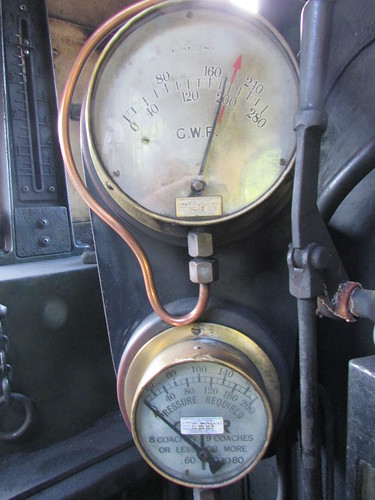
5542 Boiler and carriage warming pressure gauges.
Water Supply
On 5542, water is carried in two side tanks extending back into the cab, coupled by a broad Balance Pipe under the boiler. The '55XX' class had redesigned side tanks, giving a total capacity of 1300 gallons. The front of each tank carries a water filler and air vent. Usually, we take water at the column at Shackerstone (shown in the picture at the top of this post) after each round trip. Whilst running out of steam on a trip is embarrassing, at least the situation can be improved with time. But running out of water leaves the crew with no alternative but to 'throw out the fire' and totally disable the locomotive. Swindon provided their products with float-type water gauges and a tapered column rises above the fireman's side water tank in the cab indicating total water remaining in both Feet and Gallons.
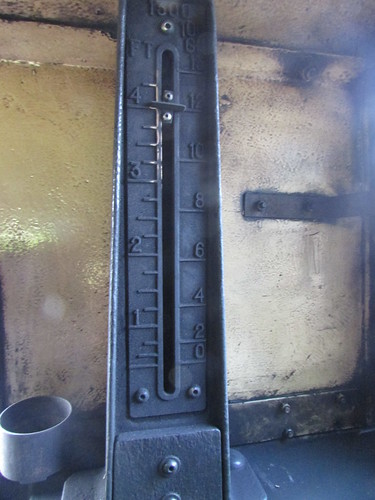
5542 Water Gauge.
Although a full tank (1300 gallons) allows at least two round trips at Shackerstone, the possibility of the float gauge becoming stuck and giving a misleading reading or unexpected delays occuring, encourages crews to regularly take water.
Coal Supply
Coal is carried in a bunker behind the cab. The '55XX' class had a redesigned bunker with a 'bulge' or extension at the top to increase capacity.
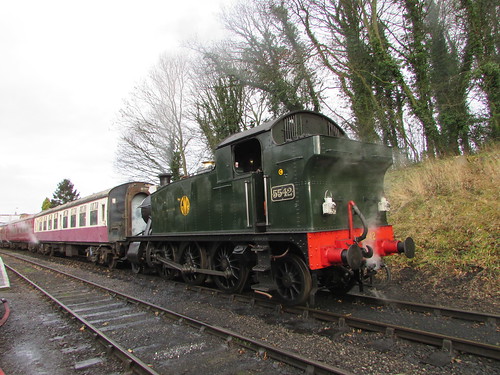
Battlefield Line 'Santa' trains 9-Dec-2017: Last 'Classic' train of the day ready to leave Shackerstone. Note the bunker extension.
Great Western locomotive boilers were designed to use Welsh Dry Steam Coal, softer than anthracite with relatively low volatile content meaning the fuel was fairly slow to initially produce heat but, once going, sustained that heat longer as each individual lump swelled and opened up, giving the appearance of a cauliflower head. Competing railways initially believed that the use of 'Welsh' accounted for the superior performance of Great Western engines but the various Locomotive Exchanges, where Great Western locomotives continued to excel using 'bituminous' coals with a much higher volatile content (like the 'Yorkshire Hards'), showed that the real secret was the carefully-proportioned boiler design and the staff training.
Deep mines producing the traditional 'Welsh' have closed but a similar coal, using opencast mining, is currently in use at Shackerstone, I believe from Ffos-y-fran open cast coal mine in East Merthyr. It has many of the desirable features of traditional 'Welsh' but doesn't seem quite as good as the deep-mined Welsh I remember from my time at Birmingham Railway Museum. Any soft, Welsh coal is 'friable' and breaks up into dust readily. It's usually quoted as the reason the Great Western stayed with hand-coaling of locomotive tenders using men tipping skips of coal on a coal stage rather than investing in automated plant as widely used on other railways.
Events of Saturday, 21st July 2018: Diesel Substitution
2018 distinguished itself by providing a long, hot summer. With an absence of rain and farmers not yet having harvested, a number of preserved railways had to temporarily cancel steam operations because of the risk of setting fire to crops. The Battlefield Line was no exception and, on a number of dates, the Diesel Multiple Unit (DMU) replaced 5542. I'd been booked on 5542 for Saturday, 21st July, which was one of the cancelled steam days, so ended up with another DMU driving turn, which prompted the latest post here about DMUs. Following a period of cooler weather with rain, steam operations were able to resume.
Events of Saturday, 18th August 2018
I arrived at Shackerstone shed to find that Jamie, who was firing, already had matters well in hand and he was filling the Sight Feed Lubricator with steam oil.
Sight Feed Lubricator
Moving parts in contact with steam (such as the valves, pistons and regulator valve) require lubrication with a special, compound mineral oil, formulated to retain its properties at high temperature. Before mechanical lubricators became common, sight feed (or hydrostatic) lubricators were often used for this purpose and Swindon developed a range of excellent lubricators. Whereas many railways left the management of these lubricators to the fireman, the Great Western placed the Sight Feed Lubricator in front of the driver. Through training and the issue of circulars, Swindon ensured that drivers understood the method of operation and the importance of the Sight Feed Lubricator. A copy of Great Western Circular 5801 issued in November 1937 by C.B. Collett can be accessed (and downloaded) here.
5542 has the Triple Sight Feed Lubricator with 4 pint oil capacity. Steam from the boiler is condensed in two coiled tubes mounted in the roof of the cab (if one fails in traffic, it can be isolated and running can continue using the second coil).
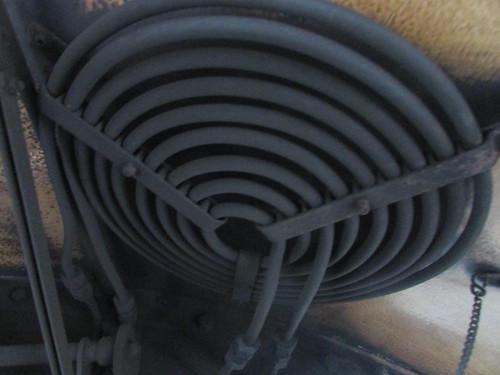
Dual condenser coils for the Sight Feed Lubricator mounted in cab roof of 5542.
The lubricator itself is bolted on the boiler backhead, in front of the driver. The body of the lubricator is filled with steam oil and, when the main cock is opened, water from the condenser displaces oil through the main gallery and, when individual nipple valves are opened from the gallery, droplets of oil form inside the sight glasses, detach and are carried through oil lines to the front end. One of the two left hand glasses (as selected by a 3-position lever on top of the lubricator) serves the valves and cylinders, the one on the right (controlled by a distinctive knob) feeds the slide valve regulator in the smokebox. For more information, refer to the Great Western Circular linked above.
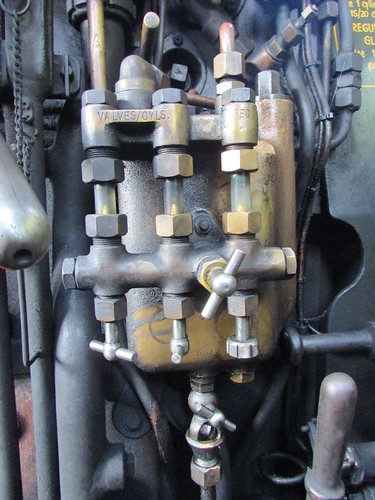
5542 Sight Feed Lubricator.
Jamie also added steam oil to the small oil cup on the feed pipe to the steam brake, to discourage the piston in the brake cylinder from sticking.
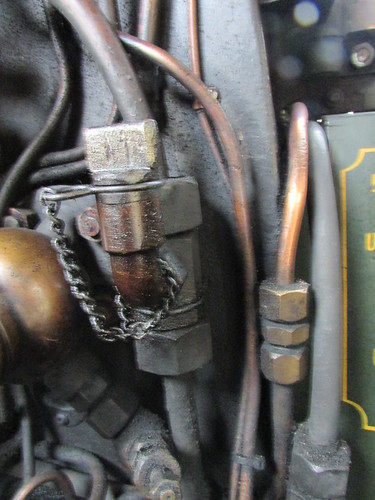
5542: Oil cup for feed pipe to steam brake.
In traffic
During the day, Jamie and I operated five round trips with a four coach train. The weather was hot, the footplate of 5524 hotter (even with the cab roof slid open). There were quite good passenger numbers and we both agreed we'd had a good day, although we were both dirty from the coal dust flying around and tired by the end of service
Related posts on this website
To see all my posts about the Battlefield Line, select Label 'Battlefield Line' or click here.
My photograph albums
Where necessary, clicking on an image above will display an 'uncropped' view or, alternately, pictures may be selected, viewed or downloaded, in various sizes, from the albums listed:-
5542 GWR Locomotive
Battlefield Line, 2017-2018
All my Battlefield Line albums
This is a list of the occasional posts I've written about a group of related locomotive classes, a particular class or, occasionally, just one locomotive in a class. Sometimes, the profile is numbered, sometimes there's just a verbal description.
Posts are listed in reverse date-of-posting order but, just to confuse, each post describes events any time in the history of the locomotive. Alternately, selecting 'Loco-profile' in the list of 'Labels to select a blog topic' will find all my locomotive profile posts (again, in reverse date-of-posting order).
Another way of searching for posts about a particular locomotive or class is to put a search word or phrase into the Search Box in the page header (with the magnifying glass symbol) because a lot of posts which talk about specific classes or engines haven't been called 'Profiles'.
Loco Profile: D.C. Electric Locomotives in the former Soviet Union 26-Nov-2019
Dugald Drummond and the 'T9' - Historical Background (10) 14-Apr-2017
G.W.R. 0-6-0PT 'Pannier' tank locomotives (9) 5-Jan-2016
The 'Austerity' 0-6-0ST locomotive (8) 27-Oct-2015
Loco-profile 7: 'Sapper' 0-6-0ST 16-Jan-2015
Loco-profile 6: 'Planet' replica 13-Nov-2013
Loco-profile No. 5: The Russian 'E' class 0-10-0 1-Jan-2013
Loco-profile 4: Russian 'FD20' class 2-10-2 24-Aug-2012
Loco-profile 3: Russian 'FDp20' class 2-8-4 24-Aug-2012
Loco-profile 2: Russian 'YeA' Class 17-Aug-2012
Loco-profile 1: "Lion" 1-Jan-2010
[List re-ordered: 4-Sep-2018, updated 19-Dec-2019]
At the beginning of October 2014, in the post The Cheshire Lines Committee, I wrote about the history of that joint railway and, in the section 'THE CLC ROUTES TODAY', I outlined what remains of these lines. That prompted me to make a trip, on 4th October 2014, travelling on the Chester-Manchester and Manchester-Liverpool routes of the former C.L.C. That trip is described here. In turn, that provoked a post about the mechanical signalling arrangements which had largely prevailed in the 1950s (here).
In July 2018, I'd arranged to visit a friend in Altrincham and decided that I'd travel there the 'long way round' (Wolverhampton-Crewe, Crewe-Chester, then Chester-Altrincham on the former C.L.C. line) to see what changes had occurred since that earlier trip described here.
Events of Tuesday, 24th July 2018
I started off on the first bus into Wolverhampton. When I discovered just how much a walk-on rail ticket from Wolverhampton to Altrincham would cost travelling before 09:30, the station staff nearly had to summon medical assistance for me but, gritting my teeth, I concluded the transaction and boarded the next Liverpool service as far as Crewe.
Whilst waiting for the diesel multiple unit shuttle to arrive from Chester, I took more pictures of the polychrome brickwork used in the numerous walls supporting the overall roofing. This use of decoration in otherwise functional building works has fascinated me since I first visited Crewe as a child.
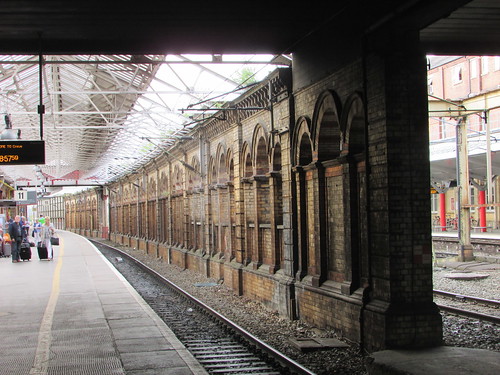
Crewe Station: Polychrome brick wall supporting the overall roofing on platform 11.
The Liverpool train which had brought me from Wolverhampton departed, then a London-bound 'Pendolino' quietly slipped away from platform 6. Later a Cardiff service from Manchester paused for a minute or two in platform 6. Shortly afterwards platform 6 was re-occupied by a 'Pendolino' bound for Manchester. An Electric Multiple Unit which had been waiting north of the station on the Up Liverpool finally sneaked across the complexities of Crewe North Junction to stable in platform 12. As it passed my vantage point, I confirmed my suspicion that this unit was empty stock. The overall impression was how quiet the station remained most of the time, compared with my recollections from steam days. Even when there were train movements, since most were electric, there wasn't much noise.
There was a fair crowd of travellers on bay platform 9 waiting for the arrival from Chester but, just before the train arrived, the public address announced a platform alteration to the next platform across, bay 10, resulting in a mass exodus as people moved to the new platform. By the time everyone had boarded, the 2-car set was full and we immediately set off for Chester where we were routed into bay platform 1.
The Chester and Holyhead Railway provided Chester Station with an imposing set of buildings, now very hacked-about after years of adaptations but still, I think, impressive. For instance, even the stairs for the station footbridge are in brick with carved stone detailing.
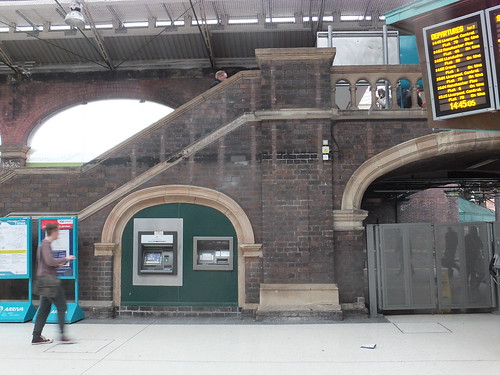
Chester: Original arches and brick and stone stairs adjacent to entrance concourse.
There was time for a few more pictures before I boarded the Class 142 2-car 'Pacer' in bay 6 which would take me to Altrincham. The hourly service from Chester to Manchester via Northwich seemed little changed since my previous trip and still uses 'Pacers'. I've commented before that I'm not a fan of these elderly 4-wheeled monstrosities but my train bowled along gamely with the underfloor bus engines working hard and finally deposited me in Altrincham about right time in just under an hour from leaving Chester.
I only noticed minor changes in the stations and signalling arrangements. Colour light signals prevailed from Chester with its unappealing Power Signal Box, past Mickle Trafford Junction signal box towards Greenbank signal box (both British Railways 'standard' designs).
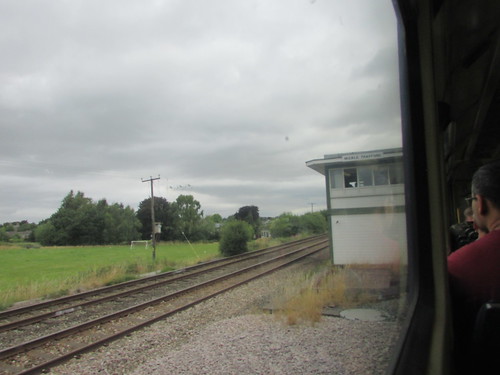
CLC from Chester: Mickle Trafford signal box from a train on the single line to Mouldsworth.
Just before Greenbank, we crossed over the electrified West Coast Main Line. Although the London and North Western manual box at Hartford Junction, a little to the north is long gone, the junction itself remains in a modified form, with a chord which joins the C.L.C. at Greenbank.
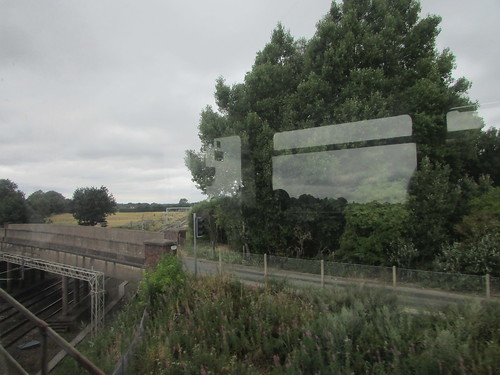
CLC from Chester: Crossing the West Coast Main Line, view looking north.
I noticed that Greenbank station (and probably others) had a different pattern of automatic ticket machine from that in use in 2014. I was glad to see that the Up platform at Northwich retains the extensive range of station buildings with its elaborate platform canopy.
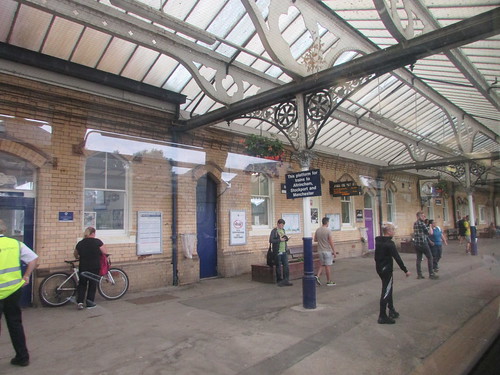
CLC from Chester: Northwich station Up platform.
Lostock Gralam Up platform has one of the dreadful 'bus shelters' plus a modern station nameboard with the interesting invitation:-
Take the Train
Walk the Canal
Visit the Lion Salt Works
The Lion Salt Works is now a museum, operated by West Cheshire Museums, illustrating the open-pan method of salt production. At least Plumley station retains its simple C.L.C. platform shelter, with patterned brickwork.
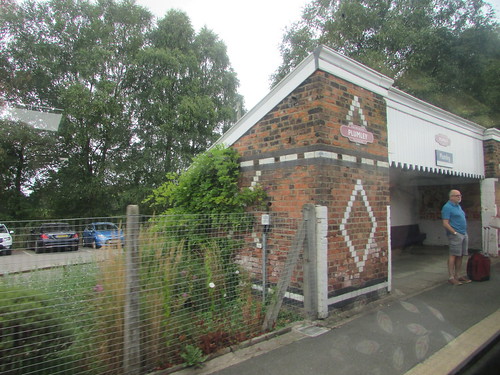 Plumley station: C.L.C. shelter on Up platform.
Plumley station: C.L.C. shelter on Up platform.
We crossed over the M6 motorway, with its inevitable road works on the southbound carriageways and made our stop at Knutsford where the wide Up platform has an attractive canopy with cast iron framework and wooden panels in herringbone pattern.
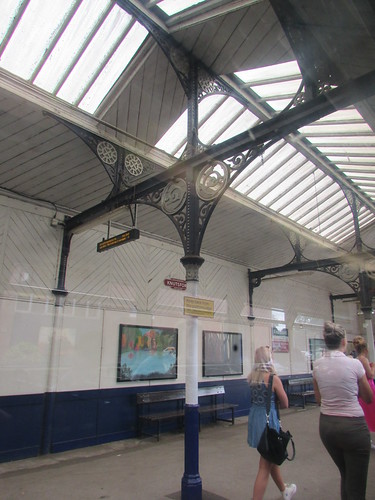
CLC from Chester: Knutsford station Up platform.
My train stopped at Mobberley, Ashley and Hale before I left the train at Altrincham, right time at 10:59.

CLC from Chester: Altrincham station platform 3 with Class 142 about to depart for Stockport and Manchester Piccadilly.
Returning home
Late afternoon, I was back at Altrincham station, now called Altrincham Interchange. In addition to being served by the Chester - Manchester service, it is now the terminus of one of the Manchester Metrolink Lines and a bus terminus is incorporated.

Altrincham Interchange: Modern concourse. The original brick station building can be see left background.
The first railway serving Altrincham was started in 1845 as the Manchester South Junction and Altrincham Railway (MSJ&AR) outlined on Wikipedia here. The expansion of Manchester and the increasing importance of Altrincham as a commuter destination lead to the line being electrified at 1500 volts d.c. in 1931. When the Electric Multiple Units (EMU) became life-expired, British Rail decided to convert the line to 25 kV a.c. and the line re-opened in 1971 using Class 304 EMU. The a.c. service was withdrawn at the end of 1991 to allow the line to be converted, again, this time to 750 volts d.c. and services to Altrincham resumed with modern trams in June 1992 as part of Metrolink. There's an article about these changes in electrification on the Light Rail Transit Association site here.
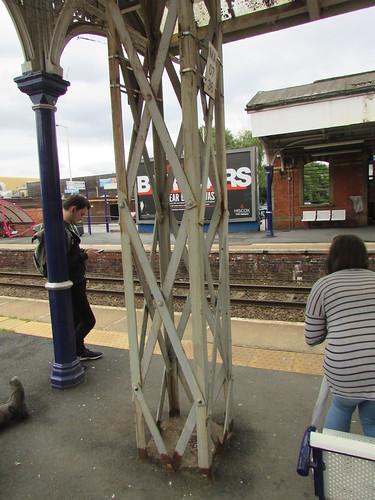
Altrincham: This overhead Line structure, on platform 2/3, with its riveted construction, apprears to date from the 1931 electrification.
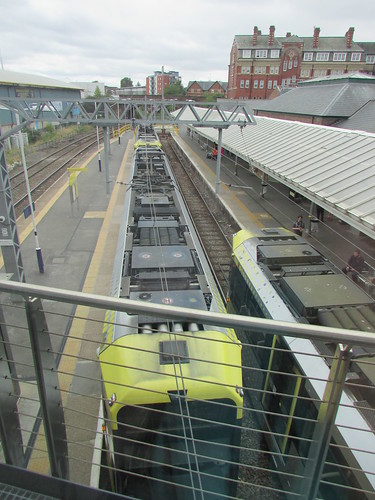
Altrincham: Looking towards the buffer stops on Metrolink platforms 1 & 2, with a 'double tram' on the left and a single tram arriving on the right.
I caught a Chester - Manchester Piccadilly service to Stockport. We were in the afternoon peak, so the miserable 'Pacer' was crowded but I managed to find a seat.
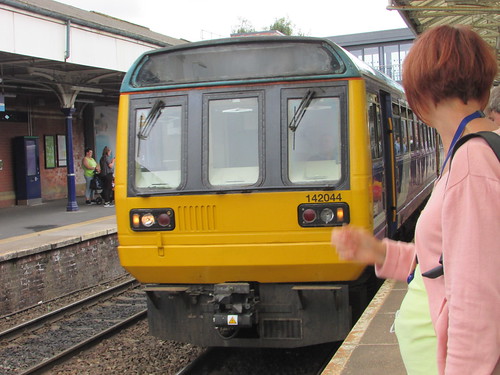 Altrincham Interchange: Manchester train arriving in platform 3.
Altrincham Interchange: Manchester train arriving in platform 3.
It was raining so I couldn't see much on the bumpy, 16-minute journey but I described this interesting route in the post on my earlier trip here.
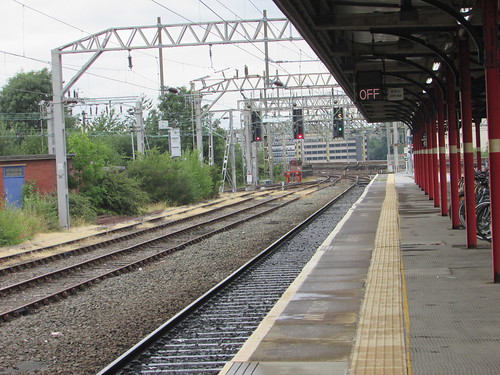
Stockport: View on arrival from Altrincham. The signal is cleared for the Slow Line which the train from Chester will take to Piccadilly.
I made my way through the subway to platform 2 and, within ten minutes, I was boarding a packed Cross Country 'Voyager' which, after brief stops at Wilmslow and Crewe, deposited me at Stafford from where I took a taxi home. Between Wilmslow and Crewe, I caught a glimpse of the Jodrell Bank Radio Telescope, with its massive dish pointing straight up.
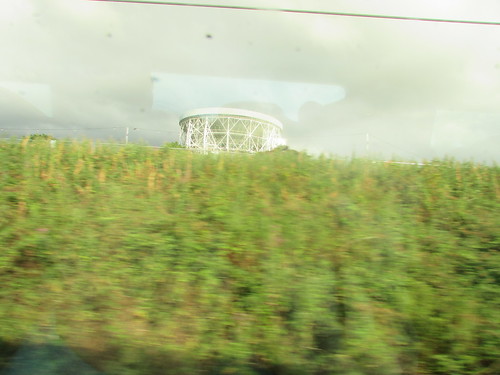
Jodrell Bank Radio Telescope.
My pictures
Where necessary, clicking on an image above will display an 'uncropped' view or, alternately, pictures from may be selected, viewed or downloaded, in various sizes, from one of the albums below. All of these albums were started before the 24th July 2018 and pictures taken on that date have been added to the appropriate album.
West Midland Railways.
Stafford Area rail.
Crewe Area rail.
North Wales Line (Crewe - Llandudno).
CLC Chester - Manchester.
Manchester Metrolink.
Manchester Area Rail.
Each year, The Old Locomotive Committee (OLCO) has an event, called 'Lionsmeet', for live steam models of the 'Lion' locomotive and similar models of designs up to around 1850. In 2018, the event was held on Saturday, 28th July at the Broomy Hill track of the Hereford Society of Model Engineers.
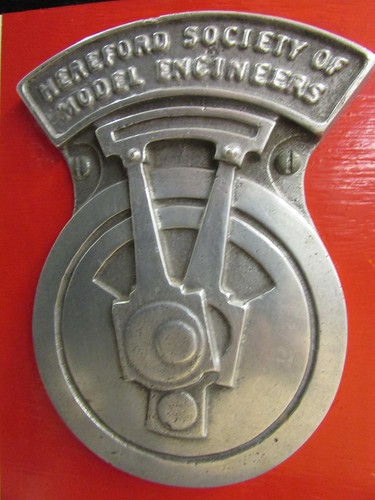
The 'shield' of the Hereford Society of Model Engineers.
Getting there
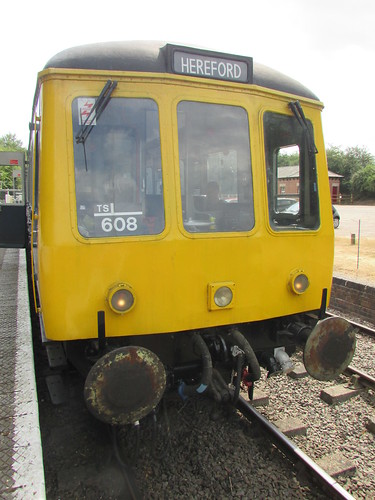
"Boarding the train to Hereford". Picture posed at Shenton on 28th July 2018.
To Hereford by train? I'm afraid it's been some years since it was possible to get to Hereford using the type of 1950s Diesel Multiple Unit shown above. However, I was rostered to drive a preserved DMU at the Battlefield Line a couple of days before 'Lionsmeet' and knowing that Hereford was one of the destinations served by Tyseley depot, the unit's last allocation before withdrawal, I couldn't resist posing this shot.
I actually travelled to Hereford in a modern Class 172 and that journey is described in the post To Hereford by rail. A taxi then took me across the city to the event. My return rail journey, via Shrewsbury, is described here.
The Event
In the summer of 2018 Britain experienced a period of unbroken hot weather extending for a number of weeks but on the journey to Hereford I'd encountered areas of heavy rain. Although it was dry on my arrival at Broomy Hill, the skies darkened and live-steam running of models was eventually curtailed by rain which started gently but later had a monsoon nature.
Our hosts, the Hereford Society of Model Engineers (HSME) are a long-established club who moved to the spacious Broomy Hill site in the 1960s, I believe. A mature and well-equipped site now greets visitors. The site is adjacent to the historic Waterworks Museum which was operating the following day (and steaming their stationary pumping engine) but, sadly, was closed on the day of 'Lionsmeet'.
At HMSE, there are elevated and ground level running tracks, together with a 20m x 30m model boating pond all laid out on a plain. The club house, workshops and an extended garden railway are situated on somewhat higher ground.
Elevated Track
I started my visit at the continuous elevated track which serves 3.5 inch and 5 in gauge models and was greeted by Lionsmeet co-ordinator Andrew Neish. I found a well-equipped station, Compton High Level, with an overall roof adjacent to raised steaming bays radiating from a turntable which were also provided with roofing. Three 'Lion' models were being prepared but early-bird Adrian Banks was already out on the running track.
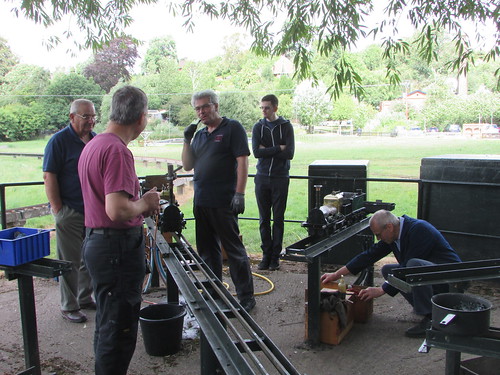
'Lionsmeet' 2018 28th July 2018: The covered steaming bays serving the elevated track radiate from a turntable.
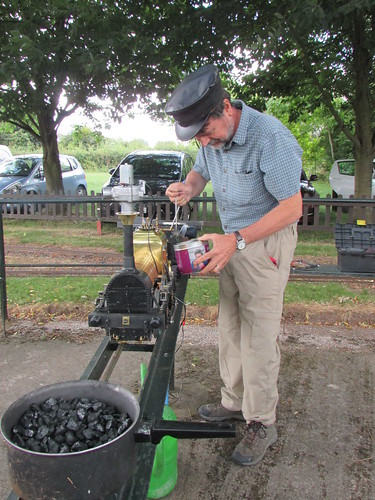
'Lionsmeet' 2018 28th July 2018: A new member of OLCO preparing his model.
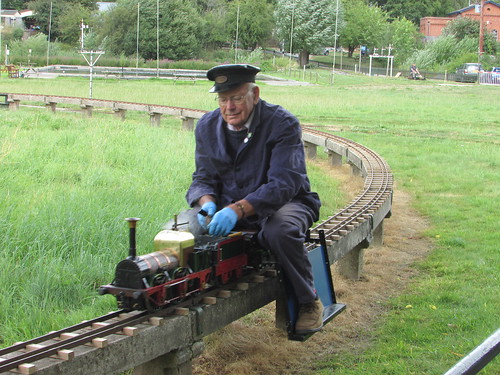
Lionsmeet' 2018: Adrian Banks was in steam early with his 'Thunderbolt' model. In the background, the model boat pool and John Dalton on the ground level track (having just passed under the 3-doll signal gantry). The brick building on the right is part of the adjacent Waterworks Museum.
A little later, after Adrian had finished his running, the other 'Lion' models shared the elevated track until deteriorating weather eventually drove everybody up to the clubhouse where for lunch and conversation.
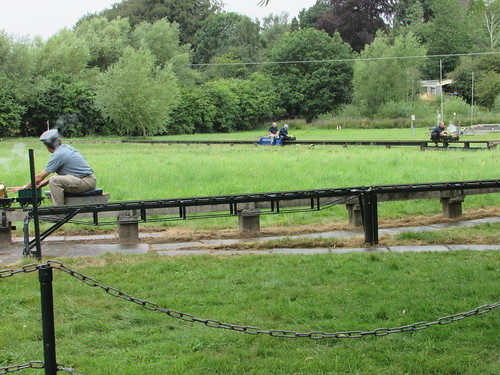
'Lionsmeet' 2018 28th July 2018: Three 'Lion' models on the elevated track at HMES.
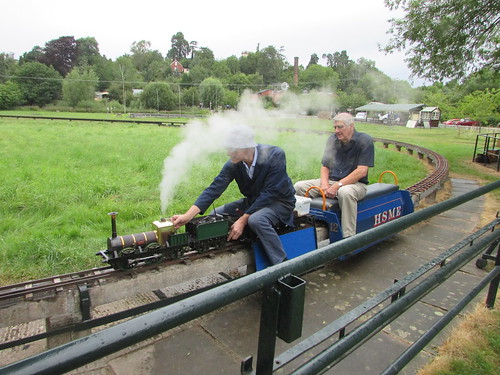
'Lionsmeet' 2018 28th July 2018: Jon Swindlehurst and his 5-inch 'Lion' with OLCO Chairman John Brandrick as passenger.
Ground Level Track
The main station on the extensive dual-gauge (5 inch and 7.25 inch) ground level track is Broomy Hill Junction, provided with an island platform with canopy, ticket office and signal box. A turnout here leads to a turntable serving a number of ground level sidings plus an incline leading to a sector table with six elevated preparation roads radiating.
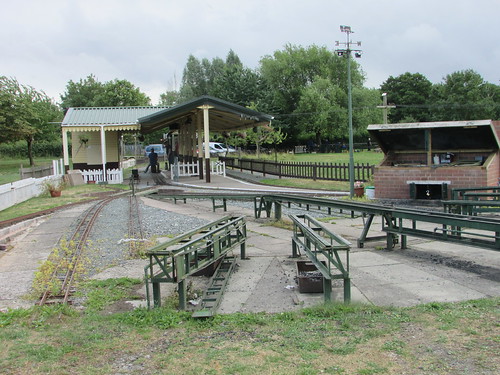
'Lionsmeet' 2018 28th July 2018: Broomy Hill Junction station with the 'HMES Shed' in the foreground featuring turntable, sidings and incline leading to a sector table with six elevated preparation roads radiating. Note the storage bunker on the right with hinging lid.
There is some complex dual-gauge pointwork in evidence, featuring 'back-drive' as now used on modern full-size railways. At least one turnout had multiple 'back-drive' and 'moving frog' construction, eliminating the problem of lack of support to wheels when passing through a 'common crossing'.
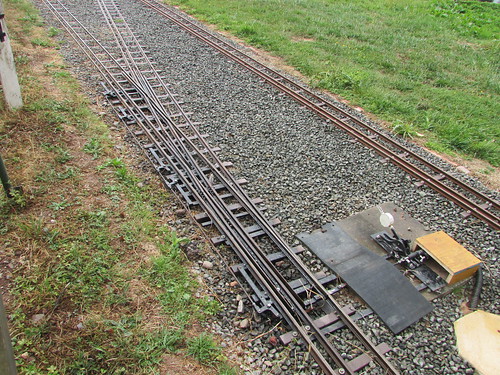
'Lionsmeet' 2018 28th July 2018: Dual-gauge turnout on HMES track featuring power operation, multiple 'back drive' and 'moving frog' design.
I noted that platform 1 through Broomy Hill Junction unusually featured 4-rail dual gauge track, rather than the 3-rail (shared rail, 5 inch rail, 7.25 inch rail) provided elsewhere. Studying my pictures later, the most likely explanation appeared to be that the line had originally been 'out and back' rather than 'continuous'. My pictures show a chord, now removed, which would have allowed out-and-back running.
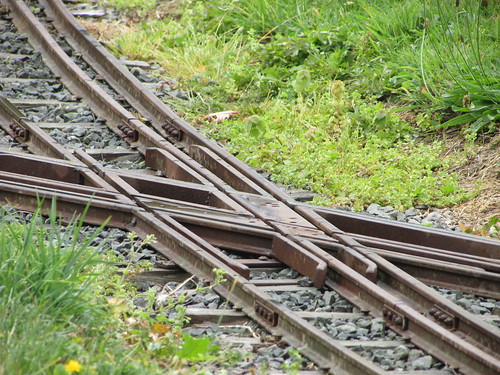
HMES Broomy Hill: A substantially-built dual-gauge diamond crossing at Broomy Hill Junction.
The ground level track is equipped with realistic, working Western Region pattern lower-quadrant semaphore signals, pneumatically operated from the miniature lever frame in the signal box at Broomy Hill Junction.
John Dalton from Chelmsford Society of Model Engineers steamed his splendid 7.25 inch gauge 'Lion' and later he was joined by resident 'modern image' model in 'Santa Fe' livery with petrol-hydraulic transmission.
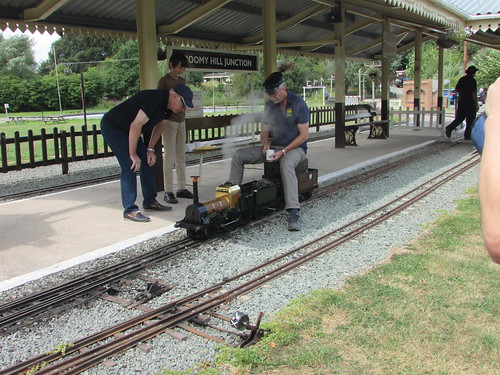
'Lionsmeet' 2018 28th July 2018: John Dalton of Chelmsford club attended with his 7.25-in gauge Lion, shown being admired by Harrye Frowen.
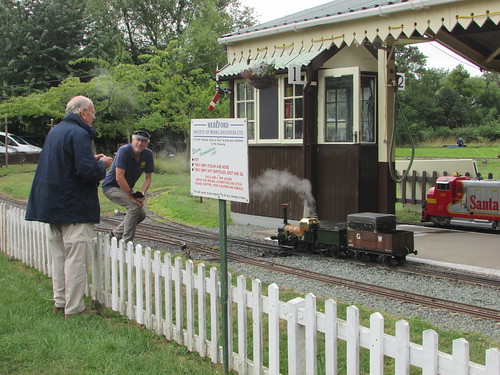
'Lionsmeet' 2018 28th July 2018: Adrian Banks chats to John Dalton about John's 7.25 inch 'Lion'. Note the signal box with working miniature lever frame and resident 'modern image' model on the right in 'Santa Fe' livery with petrol-hydraulic transmission.
Club house
As the weather deteriorated, I made my way towards the club house complex, where an excellent range of 'lunch plates' were available and animated discussions took place. A number of members were displaying models, part assembled models or components for models.
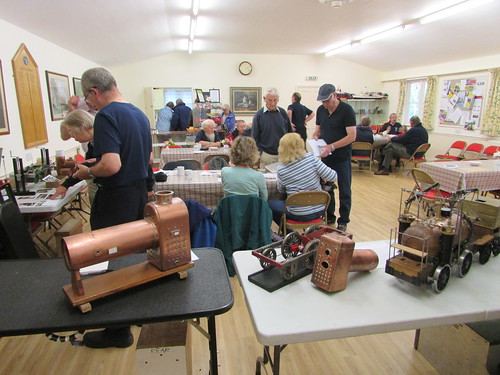
'Lionsmeet' 2018 28th July 2018: Animated discussions in the clubhouse over lunch.
Jon Swindlehust exhibited his 5 inch gauge 'Rocket' commenting that he has run it on air but not steamed it.
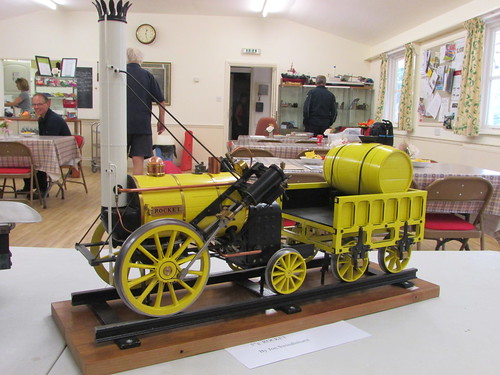
'Lionsmeet' 2018 28th July 2018: 5 inch gauge 'Rocket' by Jon Swindlehust exhibited in the Clubhouse.
Considering the 'fiddly' nature of many of the parts, Jon added that he now wishes it had been a 7.25 inch gauge model! Having worked on the full-size replica (at the Birmingham Railway Museum Gala in 1988, at the Riot of Steam in 2005 and at L & M 180th Celebrations in 2010), I was impressed by the attention to detail. The fidelity to the full-size replica operated by National Railway Museum can be judged by comparison with my picture below.

The National Railway Museum 'Rocket' replica.
But there was a model of an even older prototype on show. Harrye Frowen displayed his remarkable 7.25 inch gauge model of 'Puffing Billy' at an advanced stage of construction.
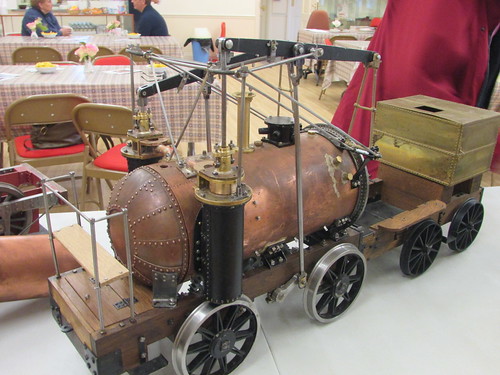
7.25 inch gauge 'Puffing Billy', under construction by Harrye Frowen.
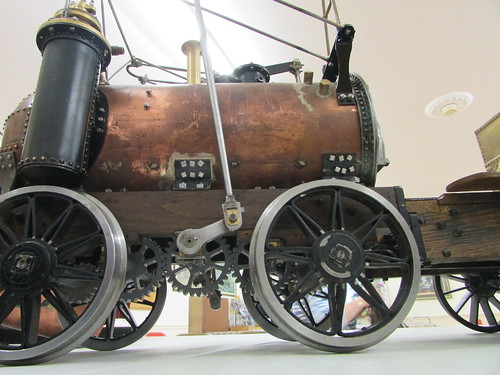
Detail of the geared 4-wheel drive on 7.25 inch gauge 'Puffing Billy', under construction by Harrye Frowen.
The 2018 'Lionsmeet' was the first since the death of much-missed founder member David Neish. His son, Andrew, displayed the familiar 'Lion' model built by David as a static exhibit since the boiler was awaiting a minor repair. That struck me as somehow appropriate.
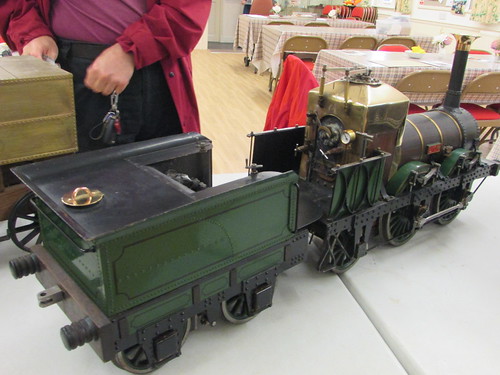
5 inch gauge 'Lion' built by the late David Neish, exhibited by Andrew Neish.
Following the death of prolific modeller Barrie Larke, his son David exhibited a variety of interesting models.
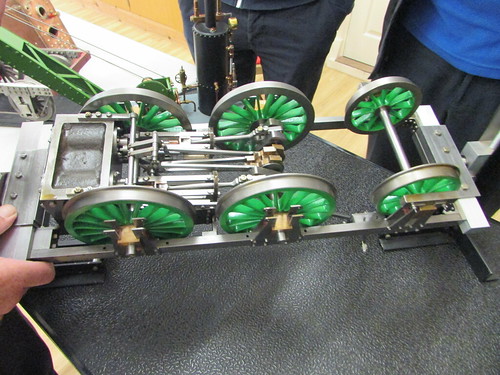
'Lionsmeet' 2018 28th July 2018: Part-built 'Lion' model by the late Barrie Larke.
The HMES Chairman Wally Sykes, a keen modeller and technical writer, gave a brief address to which OLCO Chairman John Brandrick responded, thanking the club for their hospitality.
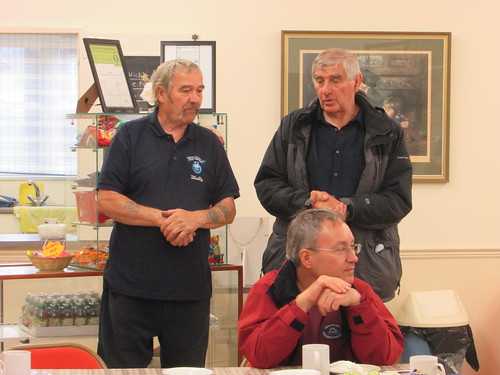
OLCO Chairman John Brandrick (right) responds to HMES Chairman Wally Sykes' address with 'Lionsmeet' Co-ordinator Andrew Neish in the foreground.
I'd been invited to explore the remaining facilities associated with the club house. Next to the clubroom, I found the Project Area with a number of projects in hand. The club has a policy of training young people in engineering, issuing its own certificates as skills are acquired to assist them in seeking employment (there's more information on the Society's website here. I spotted a '14XX' tank engine, complete with part-built auto-trailer and what I assumed was a 7.25 inch narrow-gauge locomotive under construction. One side of the project area houses a 4mm scale model railway 27 feet by 9 feet with accurately-detailed scenery only partly complete. It is based on Ledbury station, with a series of storage loops and a magnificent model of Ledbury Viaduct dominating the scene. The 31 arches of the prototype have been slightly condensed to 28. I'd travelled through Ledbury and over the prototype of the viaduct that morning, as described here. Spectators are separated from the layout by a glazed wall, made to look like the outside of a Great Western coach, complete with brass door handles!
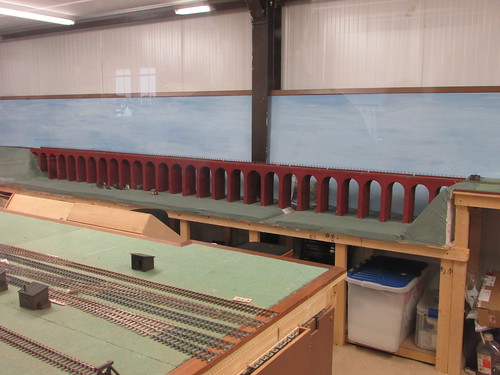
'Lionsmeet' 2018 28th July 2018: 'Ledbury Viaduct' in 4mm scale.
Outside (the rain had abated somewhat) I found two railway van bodies well-equipped as what I assumed were the original workshops. Beyond these workshops was a large garden railway. The main station (provided with both turntable and sector table) was on raised baseboards and provided with a large overall roof. Beyond the station area, the railway was on a mixture of raised baseboards and low-level formation with scenic features.
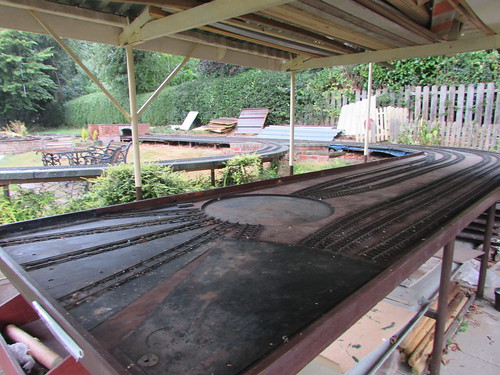
'Lionsmeet' 2018 28th July 2018: The garden railway.
The club house complex on the hill overlooks the ground level running track on the plain. The substantial carriage shed serving the ground level track has been built on two levels. The upper level, with easy access from the club house level, has its own well-equipped workshop. A ladder and an external ramp lead down to the storage tracks. A model of a GWR diesel railcar particularly caught my eye, based on one of the later batch with the rather angular body styling. When I was growing up, I remember travelling between Wolverhampton Low Level and Dudley on these railcars.
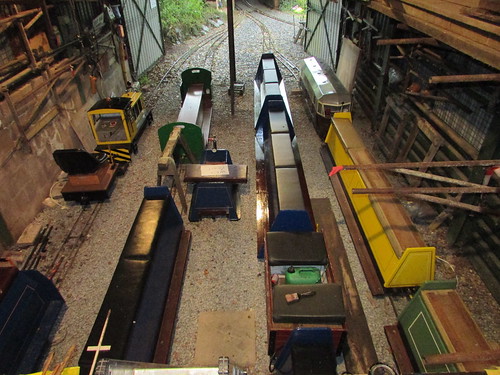
HMES Broomy Hill: Carriage shed storage tracks.
Outside the carriage shed, the four storage tracks combine into one, with the points controlled from a 3-lever ground frame. This track, flanked by the continuous ground level running track which joins from the right, passes through a double-track tunnel (which has a 'secret storage siding') before converging with the continuous track through a small station called Howards Halt, provided with steps to the higher level and the adjacent club house.
The HMES chairman had told me that the whole plains area on which the running tracks are constructed are subject to occasional flooding and up to 3 feet of water has been recorded. So I was prepared for the novel feature of a depth gauge mounted on the tunnel portal!
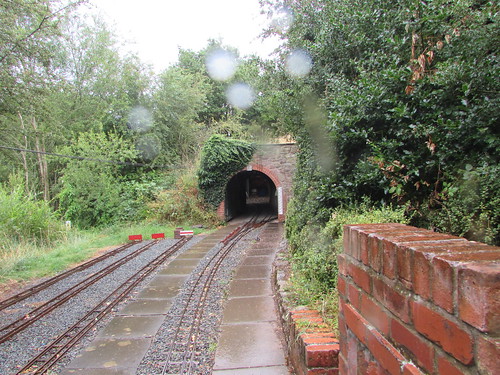
HMES Broomy Hill: The tunnel portal, with depth gauge mounted on the right side, viewed from Howards Halt. The carriage shed is just visible in the background. Note the 3 storage sidings on the left.
Well, the weather could have been better but the welcome we received from the host club could not have been warmer. After an enjoyable visit, I left Broomy Hill for my train journey home very impressed with what the Hereford Society has achieved on the site.
Related posts on this website
All my posts about the Old Locomotive Committee can be found here, with links to my pictures.
My pictures
Where necessary, clicking on an image above will display an 'uncropped' view or, alternately, pictures from may be selected, viewed or downloaded, in various sizes, from the albums listed:-
Lionsmeet 2018.
All my 'OLCO' albums.
On Saturday, 28th July 2018, I travelled to Hereford by rail, via Birmingham, to attend the 2018 'Lionsmeet' being held at Hereford Society of Model Engineers. The outward journey is described in the post here, the 'Lionsmeet' event is described here: this post describes my return.
Hereford-Wolverhampton
After I had attended 'Lionsmeet' during the day, John from the Hereford Society very kindly gave me a lift back to Hereford station. I had decided to return to Wolverhampton by a different route from the outward journey, by travelling to Shrewsbury on the former LMS/GWR Joint Line, there changing to a Wolverhampton train on the former GWR route. I'd previously travelled over the Hereford-Shrewsbury line on 26th July 2014 and described that trip in the post here.
In pre-grouping days, shown in the map below, five routes served Hereford but today Hereford is a just a through station on the Welsh Marches line from Crewe to Newport, plus the route I'd used to get to Hereford that morning which converges with the Welsh Marches line at Shelwick Junction, a couple of miles north of Hereford.
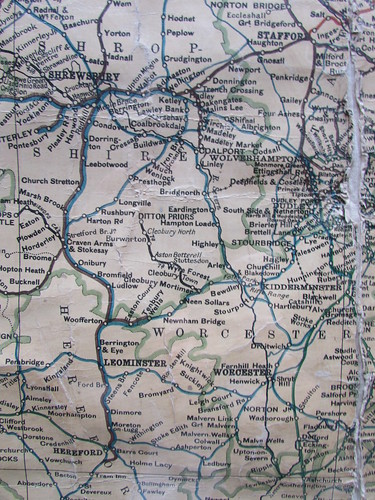
Pre-grouping railway map showing Hereford-Wolverhampton (W & A K Johnston, 'Railway Map of England and Wales 11th Edition').
Click for larger image
Waiting for the slightly late-running Manchester service which would take me to Shrewsbury gave me the opportunity to collect a few pictures around the station although intermittent rain made conditions less than ideal.
There are four roads through the station, two central Relief lines and two main lines, flanked by platforms. The Down platform (Southbound) has two faces and the outer face is used by terminating services from Birmingham. There is one signal box, south of the station on the Down side. Local points and shunting signals are mechanically operated, with power operation of more distant connections. Running signals are multiple aspect colour light.
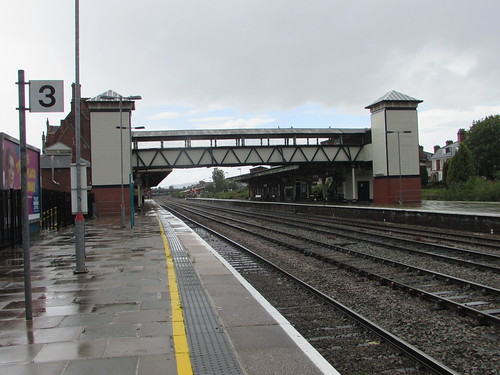
Hereford station 28th July 2018: Looking north from platform 3.
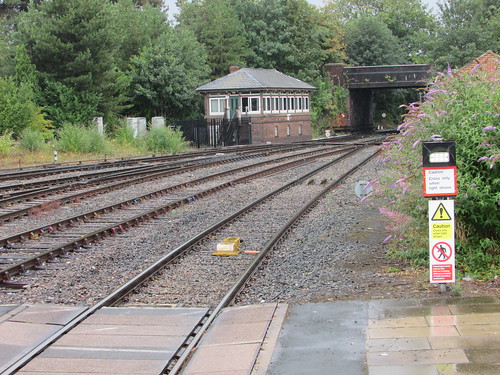 Hereford station 28th July 2018: Looking south from platform 3, showing signal box. Note barrow crossing, protected by lights.
Hereford station 28th July 2018: Looking south from platform 3, showing signal box. Note barrow crossing, protected by lights.
The 3-coach Arriva Trains Wales diesel multiple unit arrived, already fairly full, but I managed to find a seat. As we set off north in the rain I noticed, on the Up side, the remains of the two triangles which once served other railways converging on Hereford. In the early days of railway preservation, this area was home to the Bulmer's Railway Centre. Bulmer's established in Hereford in 1887 and I think were the largest cider maker in the world at one point. They are now owned by Heineken. In turn, we passed Shelwick Junction, Moreton-on-Lugg then the two single-bores of Dinmore Tunnel.
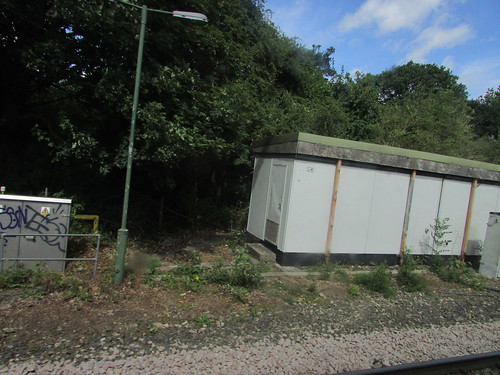
Shelwick Junction, Hereford, showing the signalling equipment room. 28th July 2018:
Just after Leominster signal box, we stopped at Leominster station. Once Leominster spawned at branch heading east to Worcester, south of the station and a second branch to the west, north of the station.

Hereford-Shrewsbury line, Leominster signal box, 28th July 2018.
I didn't even spot the site of Woofferton Junction, six miles beyond Leominster, where the branch to Tenbury Wells and Bewdley once diverged. Our next station stop was Ludlow and, seven miles further on, we paused at Craven Arms with its unattractive modern mechanical signal box.
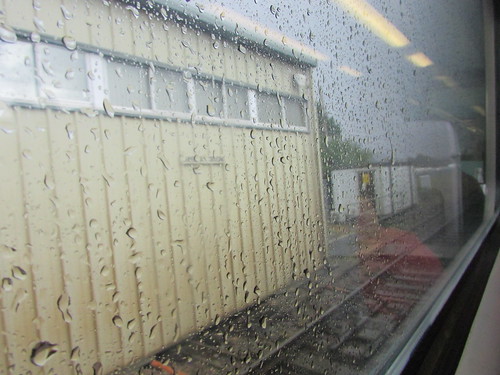
Hereford-Shrewsbury, Craven Arms Signal Box in the rain, 28th July 2018:
We made our stop at Church Stretton and then continued to Shrewsbury.
Twelve miles further on, we passed the standard Great Western design signal box at Sutton Bridge Junction, where the single Central Wales line diverges. The Great Western liked to dignify their signal boxes with a single, cast-iron name plate showing the name in full so I noticed the imposing length of the sign mounted on side facing the tracks reading 'SUTTON BRIDGE JUNCTION SIGNAL BOX'.
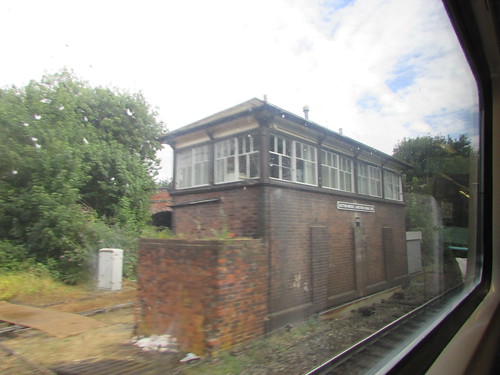
Shrewsbury area rail: Sutton Bridge Junction signal box, 28th July 2018.
The running signals at Sutton Bridge Junction are tubular post semaphore on a mixture of upper- and lower-quadrant patterns, all modified to feature better-protected access arrangements to meet modern Health and Safety requirements.

Shrewsbury area rail: Sutton Bridge Junction 2-doll Down Home, 28th July 2018.
We then passed the imposing bulk of Severn Bridge Junction which controls the south end of Shrewsbury station. This massive box always delights me because it is a London and North Western pattern construction (although, in my view, the original clean proportions have been marred by modern Health and Safety modifications).
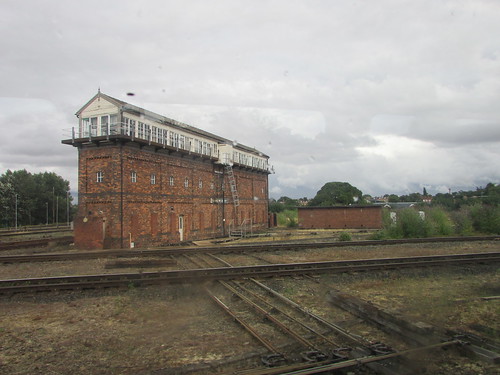 Shrewsbury area rail: Severn Bridge Junction signal box, 28th July 2018.
Shrewsbury area rail: Severn Bridge Junction signal box, 28th July 2018.
Severn Bridge Junction is now signalled by a haphazard collection of upper-quadrant semaphore, lower-quadrant semaphore and colour light signals!
At Shrewsbury, I changed to a Wolverhampton train (now operated by West Midlands Railway) after an interesting, but tiring, day.
Related articles on this site
To Hereford by rail.
A Trip to South Wales (Part 2).
Railways around Shrewsbury.
My pictures
Where necessary, clicking on an image above will display an 'uncropped' view or, alternately, pictures may be selected, viewed or downloaded, in various sizes, from one of the albums below:-
Shrewsbury-Hereford line.
Shrewsbury area railways.
Wolverhampton to Shrewsbury Line.
Wellington, ex-Great Western Railway.
West Midland Railways.
[Link to 'Lionsmeet' event added 26-Aug-2018]






















































